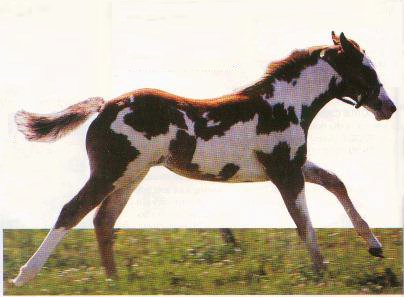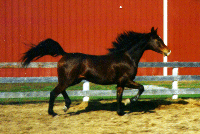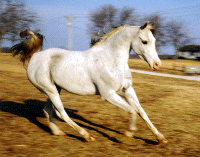
The Pinto Horse Association and the American Paint Horse Association, both with their headquarters in Fort Worth, Texas, both register part-colored equine. The Pinto Horse Association registers any breed of horse or pony that meets its color requirement, dividing them into stock type, hunter, pleasure type, and saddle type. It has a similar classification for ponies. The American Paint Horse Association registers the offspring of horses with Paint, Quarter Horse, and Thoroughbred registration papers.
The Pinto (sometimes called the Paint Horse) differs from the Appaloosa in that his spots are large patches of color. There are two types of Pinto spot patterns: the overo and the tobiano, and two colors: piebald and skewbald. Piebald refers to a coat with large patches of black and white while skewblad refers to a coat with large patches of brown and white. A Pinto having a chestnut coat with white patches is called overo (a dark coat with light patches); a white coat with colored patches is called tobiano.
The Paint or Pinto horse can be traced to the two toned horses introduced by Spanish explorers. Inevitably, some of these colorful horses escaped to create the wild herds roaming the Great Plains. Captured and gentled, they raced alongside the vast buffalo herds and traveled hundreds of miles on cattle drives. Cherished by the finest horsemen of the Western frontier, the hardy horses loudly splashed with color were sought by both Native Americans and cowboys.
Stands between 15 and 16 hands high.
Good legs and hooves are sought, most part-colored horses fulfill this requirement.

In the late 1600's and early 1700's, European breeders crossed several stallions with their own horses to produce the first thoroughbreds. Thoroughbreds are high-spirited, sensitive horses which have powerful lungs and strong legs which makes then especially well-suited for racing. Thoroughbreds are also used for jumping and hunting. In addition, many polo ponies are part thoroughbred.
The usual coloring for thoroughbreds is solid, bay, chestnut, black or brown. Grey coloring is occasionally found, but no albinos, palominos, or pintos. White markings are frequently seen.
The breed evolved in England in 17th and 18th centuries when native "running horses" were crossed with oriental stallions. The foundation horses were the Byerly Turk (1689), the Darley Arabian (1704), and the Godolphin Barb Arabian (1728). They produced the four principal Thoroughbred lines: Herod, Eclipse, Matchem, and Highflyer, who was Herod's son.
It stands between 15 and 17 hands high.
The Thoroughbred is the fastest horse there is.



The Palomino horse is not a breed but a color. The Palominos coloring occurs in a variety of horses and ponies as well as established breeds. In the United States, it has it origins in from the original horses brought to the new world by the Spanish Conquistadors for much of it physical attributes and coloring. Palominos are bred by crossing a registered Palomino with an Arabian, Quarter Horse or Thoroughbred.
Palominos have a golden coat and a light blond or silvery mane and tail. Most of them have white only on the face and on the hocks and knees.
Although not strictly a breed, Palomino horses are bred extensively in the United States.
The American Palomino Horse Association registers horse meeting specific standards and measuring between 14.1 and 16 hands high.
In Mexico, they are called "Ysabellas" in honor of the Spanish queen, Isabella and in Spain they are simply called "Caballos de Oro", or Horse of Gold.